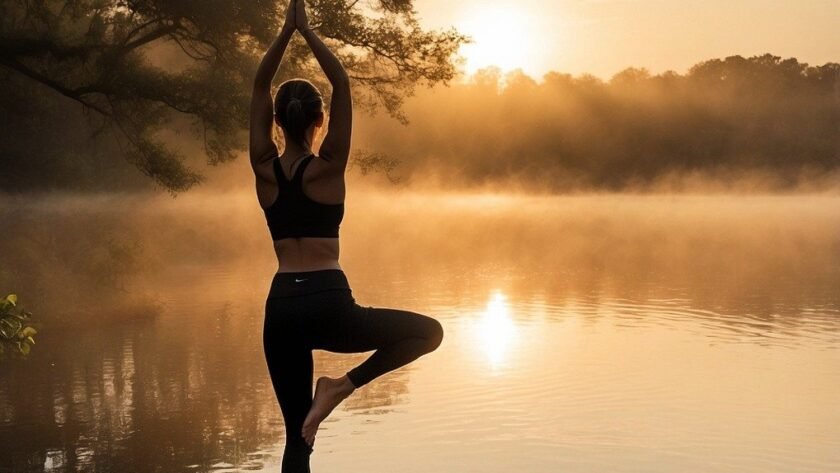Quick Summary for Busy Readers:
Practice these yoga poses for quick stress relief:
- Child’s Pose: Relaxation and calm
- Bridge Pose: Opens the chest and relieves tension
- Legs Up the Wall: Promotes deep relaxation

In-Depth Guide
Understanding Stress and Its Impact
Stress is your body’s response to situations that demand attention or action. Chronic stress can lead to severe health issues including cardiovascular and immune system problems, anxiety, and depression. Yoga offers various techniques that help combat the physical, emotional, and psychological impacts of stress by encouraging relaxation and mindfulness.
The Science Behind Yoga and Stress Reduction
Yoga helps in reducing stress hormones like cortisol and activating the “rest and digest” response in the nervous system. This combination promotes relaxation and emotional regulation, which leads to overall improved mental health and well-being. Moreover, yoga practices such as pranayama (controlled breathing) and meditation enhance mindfulness and provide a sense of inner peace.
Top Yoga Types for Stress Relief
- Hatha Yoga: Focuses on basic asanas and breathing techniques, beginner-friendly.
- Vinyasa Yoga: Synchronizes movement with breath; more active and dynamic.
- Yin Yoga: Involves holding poses for extended periods, targeting connective tissues.
- Restorative Yoga: Utilizes props for passive poses, emphasizing relaxation.
- Kundalini Yoga: Combines postures, breathing, and meditation for spiritual awareness.
Essential Yoga Poses for Stress Relief
- Child’s Pose (Balasana): Calms the mind, relaxes the back.
- Cat-Cow Pose (Marjaryasana-Bitilasana): Releases tension in the spine.
- Downward-Facing Dog (Adho Mukha Svanasana): Stretches and rejuvenates the entire body.
- Bridge Pose (Setu Bandha Sarvangasana): Opens the chest, relieves spinal tension.
- Legs Up the Wall (Viparita Karani): Promotes relaxation, reduces anxiety.
- Corpse Pose (Savasana): Completes the relaxation process.
Creating a Stress-Relief Routine
- Identify Your Stressors: Recognize what specifically causes stress in your life.
- Choose Activities: Include yoga, meditation, and leisure activities.
- Set Goals: Achieve realistic and attainable stress-relief targets.
- Schedule Regularly: Consistency is key to effective stress management.
- Variety Matters: Incorporate different yoga styles and activities to avoid monotony.
- Mind-Body Practices: Opt for techniques like tai chi or deep breathing.
- Monitor Progress: Keep a journal of your stress levels and progress.
- Rest and Recovery: Prioritize recovery to avoid overtraining.
Example Yoga Sequence for Stress Relief
- Start in Child’s Pose for 3-5 minutes to relax and calm the mind.
- Transition to Cat-Cow Pose for 5 rounds, focusing on the breath.
- Move into Downward-Facing Dog for 1-2 minutes, stretching the body.
- Switch to Bridge Pose for 5-7 breaths, opening the chest.
- Finish with Legs Up the Wall for 5-10 minutes, allowing full relaxation.
Breathing Techniques (Pranayama) for Stress Relief
- Nadi Shodhana (Alternate Nostril Breathing): Balances the nervous system.
- Bhramari (Humming Bee Breath): Reduces anxiety and quiets the mind.
Meditation Practices
- Loving-Kindness Meditation: Promotes compassion and reduces anger.

Image by diana.grytsku on Freepik





[…] you for reading this post! For more information on yoga and wellness, check out our other […]
This post has answered so many of my questions.
I’m so pleased to hear that this post helped answer your questions! It’s always my goal to provide helpful and clear information. If you have any more questions or need further guidance, don’t hesitate to reach out. Thanks for sharing your feedback!
This is such a valuable resource. I’ve learned so much from this post, and I appreciate the practical advice you’ve shared.
Thank you so much for your kind words! I’m thrilled to hear that you found the post valuable and that the practical advice was helpful. Your feedback means a lot to me. If you have any more questions or topics you’d like to explore, feel free to reach out!